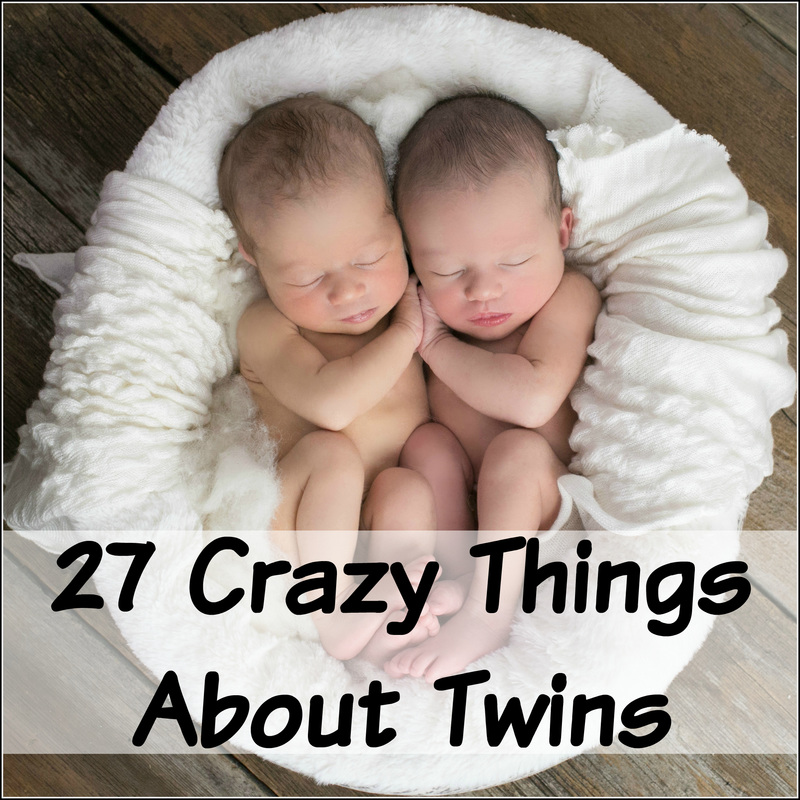|
Originally posted on Mommy Nearest (since edited) on 3/10/2015
As soon as I found out I was having twins, I became more or less obsessed with understanding everything I could about twins and twin pregnancy. Thanks to great books, Facebook support groups, and Google, here are some of the crazy, cool, and scary things I learned and am happy to pass on to you! Enjoy!!
1. Factors that increase your chance of conceiving twins
Besides IVF and fertility drugs, there are many other factors that increase your chances at having twins. Fraternal twins often run in families because of a gene causing hyperovulation (releasing more than one egg per cycle). Fraternal twins can "skip a generation" because boys don't ovulate, of course, but they'll pass the gene on to their daughters! A mother who is a fraternal twin herself has a four times higher chance of producing twins. Other factors include advanced maternal age (moms over 30 have more chance for twins), height (taller women have more insulin-like growth factor <IGF>, which results in increased sensitivity of the ovaries), breastfeeding (moms who are breastfeeding when they get pregnant are 9 times more likely to conceive twins, due to elevated IGF levels, and even moms who have weaned but nursed for at least 20 months will have a higher chance of twins), and diet (women who consume dairy may be up to 5 times more likely to conceive twins than a vegan, arguably because cows are given synthetic growth hormones and produce IGF, which is released into their milk). So, there you have it! You want twins? Do all of the above and you might just get them!! As for me, I had age, height, dairy, and extended breastfeeding (and had only weaned 2 months prior to conception) going for me and didn't even know it. Whoops!
2. The rate of identical twins is universal.
It's not effected by race, nationality, or genetics, and is about 1 in 285 births. Identical twins supposedly do not run in families (though some families with them in each generation will argue BS here), and they are much less common than fraternal twins. There are theories that there is a genetic factor in sperm that can increase the chances of the fertilized egg splitting, but nothing has been proven just yet.
3. Twins have been shown interacting in the womb at as early as 14 weeks.
4. Timing is everything!
Identical twins are the result of one egg splitting post-fertilization, but the timing of the split determines if the twins will each have their own sacs and placentas (split on day 1-3, called di/di twins - the lowest risk), share a placenta (split on day 4-8, called mo/di twins - higher risk), share an amniotic sac *and* placenta (split on day 8-13, called mo/mo twins - quite high risk), or be conjoined (split on day 13-15 - extremely high risk) - the latter of which is of course the most rare, only 1 in 200,000 births.
5. Twin To Twin Transfusion Syndrome (TTTS)
TTTS can occur when identical twins share a placenta, when one twin is getting more nutrients and blood volume than the other. It can happen at any point in the pregnancy and can result in the death of one or both twins, and is thus a huge concern for parents and caregivers. There are treatments available, so frequent exams and ultrasounds are necessary to keep an eye on the situation.
6. How do you know if twins are identical or fraternal?
For one, if they are boy/girl they are fraternal (well, actually there can be identical boy/girl twins but this is EXTREMELY rare). If they share a placenta or amniotic sac, they are identical (unless they had two placentas that fused together, which can happen but isn't too common). Other than that, you’ll have to wait until they're born to take a look at them. However, fraternal twins may *look* identical, and "identical" twins don't always look *exactly* the same, so the only way to be sure is to do the Zygosity genetic testing (which we did - read about it here), which is via a simple swab of the cheek. Knowing whether twins are identical or fraternal is not just to satisfy your curiosity, it can help you be prepared for certain health conditions identical twins would share, or warning your kids that they are likely to have twins of their own!
7. Same Same but Different…
Identical twins have nearly the same DNA (99.9% identical) and almost nearly identical brain wave patterns, but different fingerprints and teeth marks. They can also have subtle differences resulting from how they were squished in the womb, such as different head shape, or their size may be dramatically different due to nutritional differences resulting from TTTS.
8. Twins have a higher rate of left-handedness.
22% of twins are southpaws as opposed to 10% of singletons.
9. Did you eat your twin?
An estimated 1 in 8 pregnancies begins with twins with only 1 in 70 actually producing twins, thanks to “Vanishing Twin Syndrome”, where one of the babies doesn’t survive. This is usually quite early on and the embryo is reabsorbed by the mother’s body or by the surviving twin, causing no issues for the remainder of the pregnancy. So, it’s quite possible that you had twins for the first few weeks of your pregnancy and never even knew it! For others who already had twins diagnosed, only to find out later there’s just one remaining baby, it can be devastating news. Rightfully so, it’s something every mother carrying multiples worries about until they are all delivered safely.
10. "Full Term” is Relative.
50% of twins are born before 37 weeks gestation, which is considered “full-term” for twins, and most practitioners will induce by 38 weeks (the risk of still birth goes up significantly after this point for twins). The average birth weight for twins is just 5 pounds 5 ounces (as opposed to the robust 7 pound 7 ounce average singleton). I feel so lucky our girls made it to 39 weeks 6 days before we were finally induced and had a beautiful safe vaginal delivery (read about it here). Our girls were 6 pounds 11 ounces and 5 pounds 9 ounces.
11. Twins can have different birthdays.
While extremely rare, it’s possible to birth one twin days, weeks, or even months before the other! The current record is twins born 87 days apart (the first twin was born 4 months premature).
12. Twinning highs and lows.
Nigeria has the highest rate of multiple births (4%), whereas China has the lowest (about 1.1%, though it should be noted that they waive the one-child-policy in the case of multiples, which are just counted as a single birth). The rate in the US is about 3% of births.
13. Baby A / Baby B
Baby A refers to the twin located lower in the womb with Baby B being higher. For higher order multiples, the lettering of babies continues for all in order of their closeness to the cervix.
14. Twins put you in the “high risk” category but don’t necessarily mean a Cesarian Section.
Many practitioners will agree to try for a vaginal birth if Baby A is head down and larger than Baby B. Once Baby A is born, Baby B should be able to be born in any position or a practitioner may try to manipulate them into a head down position. Most hospitals and doctors will require you to deliver in the OR, just in case you need an emergency c-section for the second baby (the dreaded "double whammy" birth and recovery).
15. The average time between delivery of the first and second twin is 17 minutes. (Mine were 6 minutes apart).
16. Many parents worry about telling their identical newborns apart.
If there’s no easy distinguishing factor (such as size, birthmarks, cowlicks, or moles), some take to painting a toenail in an identifying color, using infant-safe jewelry, or color coding wardrobes. Also, once the umbilical cords fall off, their belly buttons can be a giveaway.
17. Polar bears most commonly birth twins (and very rarely singletons or triplets).
18. About 25% of identical twins are “Mirror Image Twins”.
This means they are exact reflections of one another. For example, if one has a freckle under the left eye, the other’s freckle will be under the right eye, cowlicks will run in opposite directions, etc.
19. Polar Body / Half Identical Twins
These are the result of one egg that split, and then each half became fertilized by different sperm. They will share 75% of their DNA - which is more than regular siblings or fraternal twins but less than identical twins.
20. Healthier moms have twins?
A study in the Journal Proceedings of the Royal Society B that focused on mothers in the 1800’s suggests “Twins could be an evolutionary adaptation in which healthy moms take the chance to pass on double their genes at once.”
21. Twins can have different fathers!
It’s extremely rare, but let’s say the women releases more than one egg and goes on to have intercourse with two different men in her window of peak fertility… boom… fraternal twins with different dads!! And a whole lotta explaining to do! HA!
22. Twins can be different races!
Fraternal twins (i.e. two eggs that got fertilized separately) can look identical or completely different, even black and white. It’s basically a genetic roll of the dice which genes each baby will receive from mom and dad. Fraternal twins are no more alike than any siblings, they just happened to share a womb and birthday.
23. 40% of twins develop their own language.
Sounds cool (and is super cute, have you seen this viral video!?, but actually this can happen when any similarly aged babies are around each other a lot and developing language skills at the same rate. This made-up language usually disappears once the children learn the real language that allows them to communicate with others.
24. If two sets of identical twins married each other...
Their children would technically be cousins but the cousins would have the same genetic closeness as actual siblings. Mind. Blown!!!
25. Celebrities with twin siblings:
Scarlett Johansson has a twin brother, Kiefer Sutherland has a twin sister, Ashton Kutcher has a fraternal twin brother with cerebral palsy, Gisele Bundchen has a fraternal twin sister, Napoleon Dynamite (aka Jon Heder) has an identical twin brother, Isabella Rossallini has a fraternal twin sister, Alanis Morissette has a twin brother, Ashley and Mary Kate Olsen are fraternal twin sisters, Vin Diesel has a twin brother, and Tia and Tamera Mowry are identical twin sisters (though they didn’t find out til they took the test at 35 years old!).
26. Celebrity parents of twins:
Angelina Jolie & Brad Pitt, Mariah Carey & Nick Cannon, Celine Dion & Rene Angelil, Julia Roberts, Jennifer Lopez & Marc Anthony, Sarah Jessica Parker & Matthew Broderick, Ricky Martin (via surrogate), Anna Paquin & Stephen Moyer, Rebecca Romijn & Jerry O'Connell, Julie Bowen, Holly Robinson & Rodney Peete, Marcia Cross (via IVF), Elsa Pataky & Chris Hemsworth, Lisa Marie Presley, Jon & Kate Gosselin, Mia Hamm & Nomar Garciaparra, Diana Krall & Elvis Costello, Zoe Saldana & Marco Perego, Neil Patrick Harris & David Burtka, and Sarah Shahi & Steve Howey.
27. There is a Twins Day celebration held in Twinsburg, Ohio.
Pretty awesome, huh? Did I miss anything crazy, cool, or scary about twins? Are you a twin, parent of twins, or hoping to be? Share in a comment below! And don't miss this post about how to prepare for having twins!!
7 Comments
Mary Gardner
11/5/2019 03:16:19 pm
I am the parent of fraternal twin boys and one of them has fraternal twin girls. It is so interesting to learn about twins and to watch them grow together. I know that sometimes fraternal twins can look identical but I didn't know that the Olsen twins were fraternal.
Reply
Monica Simpson
8/20/2021 11:51:05 pm
These were so interesting to read! I had no idea twins could be born months apart. I also didn't know boys and girls can be identical.
Reply
8/21/2021 11:28:10 am
Twins are so cool! They run in my family so perhaps one day.
Reply
Leave a Reply. |
About ME:I'm a NYC metro area mom blogger living in NJ with my Japanese husband & our 3 kids (twins plus 1), focusing on fun and honest product and travel reviews, saving moms time finding the best for their families! Find what you need in the menu bar or search section above! Categories
All
Archives
July 2024
|












 RSS Feed
RSS Feed



